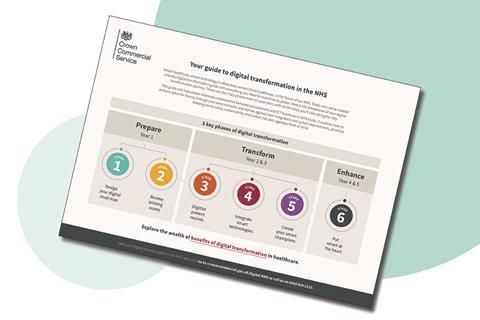Crown Commercial Service has produced a guide for NHS bodies that need to carry out digital transformation.
How, where, and when patient care is given is changing.
Sponsored by
There’s a natural evolution towards smart healthcare services, where technology is embedded across clinical pathways and the digital patient is the new normal. It’s vital that our NHS health services, staff and patients are ready for this. Because ultimately, smarter healthcare means more efficient, and safer patient care.
Health organisations, at whatever stage of their smart healthcare journey, require a robust technology procurement strategy that builds close collaboration between their procurement and ICT functions.
They’ll also need to achieve value for money through their procurements, delivering against clear integrated care system requirements and cost improvement programmes - all while keeping social value and carbon net zero agendas front of mind.
At Crown Commercial Service, the UK’s largest public procurement organisation and an executive agency of the Cabinet Office, we’ve put together a step-by-step guide to buying digital transformation solutions in the NHS. We explore the three main phases, with a clear breakdown of the programme stages and projects along the way.

Year 1 - Prepare
Step one is to develop the technology strategy that aligns with your NHS trust’s organisational development plan and its intended outcomes. From here, you can develop your programme, create your design and delivery structure, prepare outline and full business cases, and allocate budgets.
Next you’ll need to review your existing assets with the aim of getting the maximum value from what you already have. Where do you need to refresh your core infrastructure and networks? How can unified communications bring together phone, email and instant messaging to complement each other and encourage collaboration? You’ll also need to consider how your devices, applications and databases will be rolled out and managed, and how cyber security requirements can be met across every aspect of the IT estate.
Years 2 and 3 - Transform
Consider the example of digitising patient records. These can be integrated into software and clinical systems, facilitating the delivery and receipt of patient data digitally at the point of service. If you need to scan historic paper records, consider what further processes and resources are required. You’ll need a validation process to check that scanned documents match the original paper versions, and create new workflows to ensure they are available securely.
Smart technologies can also be deployed to enable patient participation and empowerment throughout their clinical pathways. You could integrate systems such as picture archiving and communication, radiology, pathology, pharmacy, and bedside monitoring, focusing on interconnection and sharing of data, using unified messaging standards such as Health Level Seven. Review your data warehousing and how a central data store could improve your reporting and analysis; you should also build integration into your solutions, considering how you can extend use securely to other organisations such as primary, acute, mental health, and social services.
Years 4 and 5 - Enhance
The human element cannot be lost in any process of digital transformation. Smart champions, involved at the implementation stage of your training programme, will be able to take more ownership of the process. Training providers can create bespoke training programmes that empower users and tackle change resistance. Real time data and intuitive dashboards can inform your decision making, providing more accurate clinical coding, and enhancing the analysis of current and future activity. You may even want to consider how apps could help improve the patient experience and provide easy access to clinical services.
At this stage, you should be aiming to put the digital patient at the heart of everything you do. You can prescribe digital solutions to the most vulnerable and disadvantaged, but ensure that all healthcare services are inclusive, and think about how you can help patients to gain the basic digital skills they will need to access digital health services independently - and support those who can’t. Focus on early intervention and prevention initiatives with your fellow integrated care system providers.
Find out more
CCS has developed a free, easy to use guide to digital transformation in the NHS. Find out more and download the guide from the CCS website.





























